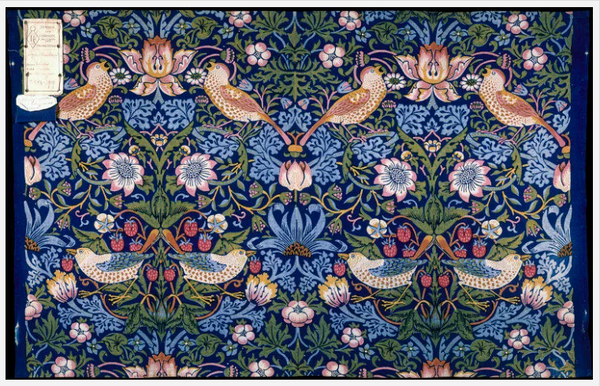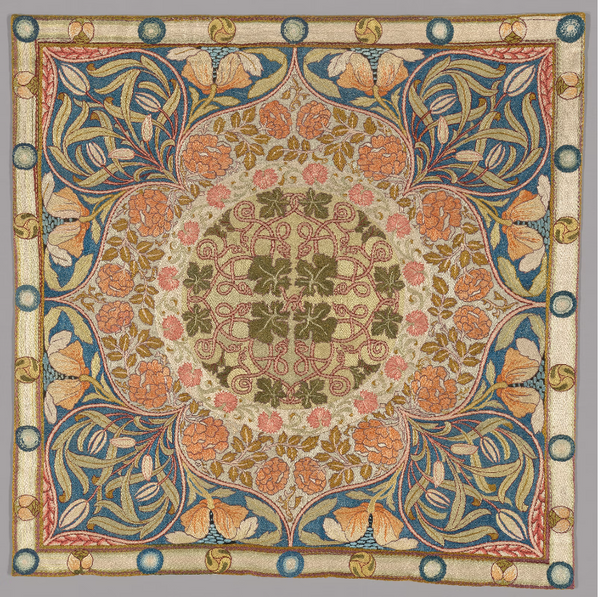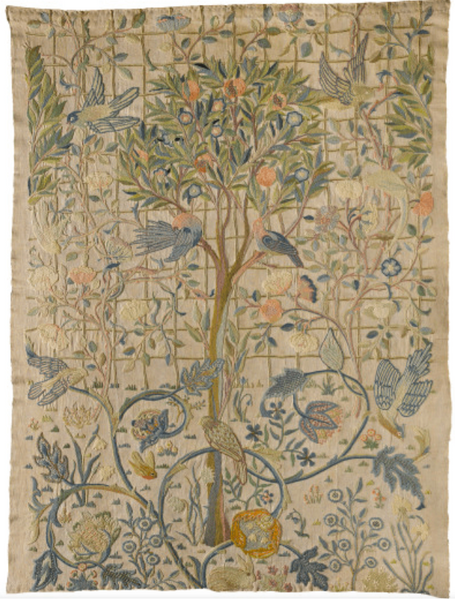
The Arts & Crafts Broderer - Spring 2022 Story Collection is inspired by the work of May Morris and her embroidery designs of the late-19th and early-20th centuries. “Broderer” is an English term dating back to the Middle Ages referring to a hand embroidery worker. The collection celebrates an exceptional woman who influenced and elevated decorative needlework from the domestic realm into a celebrated artform.
Beginning around 1880, the Arts & Crafts movement was popularized in England by William Morris (1834-1896) and his followers as a response to the industrial revolution and the effects of mass production on the decorative and creative arts. The style featured motifs from nature and was applied to interiors, architecture, art, and everyday objects. Morris & Co. (William Morris’ company and guild) was a powerful stylistic influencer of its time, eventually spreading the Arts & Crafts style across the world.

William Morris & Co, Strawberry Thief, V&A Museum.
Recent scholarship on the work of Morris & Co. reveals that many of the company’s most popular designs were actually created by William Morris’ youngest daughter, May Morris (1862-1938). May was a designer, embroiderer, writer, educator, lecturer, and women’s rights advocate. Women were commonly not given credit for their work in design studios and guilds in the 19th and 20th centuries, and there is still much to learn about May Morris and her contributions as an important and influential artist and businesswoman.
According to the Guardian: “May Morris was one of the leading artists of the Arts and Crafts movement whose designs for everything from wallpaper to baby’s Christening mittens became the defining feature of many a wealthy, progressive household at the beginning of the 20th century. In particular, May’s brilliance at needlework helped raise what had previously been a trivial female hobby or, worse still, domestic drudgery, into fine art.” (Hughes).

May Morris stitching at home, Hammersmith, London, 1921, The William Morris Gallery.

May Morris stitching a tapestry, undated photograph, National Portrait Gallery, London, Photographs Collection.

May Morris embroidery design, V&A Museum collection.
After completing her studies in textile arts from the South Kensington School of Design, May became director of the embroidery studio of Morris & Co. in 1885 at the age of 23. The embroidery studio was an important part of Morris & Co. and embroidered textiles were some of the first furnishings designed and sold by the company. May designed patterns for textiles and interior decor, and also created elaborate embroidery commissions including wall hangings, altar cloths and tapestries. Her honeysuckle design is one of the company’s most celebrated wallpaper patterns. Many of her commissioned pieces are held in the collections of world-famous museums including the V&A in London. The company also sold embroidery kits as a means of encouraging embroidery as an everyday art practice.
 May Morris, Honeysuckle wallpaper design, The William Morris Gallery collection.
May Morris, Honeysuckle wallpaper design, The William Morris Gallery collection.

Vine Leaf table cover, designed by May Morris, produced by Morris & Company, 1896. Crab Tree Farm Foundation Collection, Art Institute of Chicago.

May Morris design, ca. 1900. Referenced in Burr.

Evening bag designed by May Morris, William Morris Gallery.
After William’s death in 1896, May left Morris & Co. but remained an advisor. She became a passionate advocate for craft, lecturing and writing articles and books on embroidery, including “Decorative Needlework” in 1893. She was also an advocate of equality for women and co-founded the Women’s Guild of Arts in 1907, to ensure that women were represented in Arts and Crafts Exhibition Society shows and that they received credit for their work. She also taught at the Central School of Arts and Crafts and lectured in America and worked on monographs of Morris & Co. in the early 20th century.

Feather stitch diagram in Decorative Needlework by May Morris, 1893.

Bed curtains, May Morris, 1916, Cranbrook Art Museum.
The Arts & Crafts Broderer - Spring 2022 Story Collection includes four mini skeins (each approx. 25g) of worsted weight 100% superwash wool milled in the US. The collection will be available to order from our web shop starting on Sunday, May 1 at 9am PST here: https://quillandquiverfiber.com/products/the-arts-and-crafts-broderer-spring-2022-story-collection
The colorways in the collection are (clockwise from top left):

 |
Midnight - An inky blue gradient fading from muted sapphire to navy. |
 |
Cotswold Green - This soft sage green is composed of equal parts of pale olive, mint and jade, and is inspired by the surroundings of the Morris family’s country retreat. |
 |
Bluebell - This pastel lake blue has subtle hints of washed denim and periwinkle
|

|
May Rose - A pale carnation pink with accents of dusty rose and muted blush. |
Sources for more information:
- “The Arts and Crafts Movement and William Morris.” The History of Art, https://www.thehistoryofart.org/william-morris/arts-and-crafts-movement/. Accessed 17 April 2022.
- Beattie, Sarah. “Unsung Artists : May Morris (1862-1938) • V&A Blog.” V&A, 24 April 2015, https://www.vam.ac.uk/blog/caring-for-our-collections/unsung-artists-may-morris-1862-1938
- Burr, Trish. “May Morris.” The Brooklyn Refinery, https://thebrooklynrefinery.com/may-morris/. Accessed 17 April 2022.
- Hughes, Kathryn, et al. “Family tree: the exquisite brilliance of William Morris's daughter.” The Guardian, 29 September 2017, https://www.theguardian.com/artanddesign/2017/sep/29/family-tree-the-exquisite-brilliance-of-william-morriss-daughter
- Lister, Jenny, Jan Marsh, and Anna Mason. “May Morris Arts and Crafts Designer”. London: Victoria and Albert Museum, 2017.
- Morris, May. “Decorative Needlework.” 1893, https://thebrooklynrefinery.com/wp-content/uploads/2020/06/Decorative-Needlework-by-May-Morris.pdf
- Watt, Melinda. “May Morris: Designer and Advocate | The Art Institute of Chicago.” Art Institute of Chicago, 7 December 2021, https://www.artic.edu/articles/953/may-morris-designer-and-advocate. Accessed 17 April 2022.
Images credits: The William Morris Gallery, V&A Museum, Art Institute of Chicago, William Morris Society in the United States, and “Decorative Needlework” by May Morris.
Copyright: Quill & Quiver Fiber, 2022. All Rights Reserved.

Leave a comment